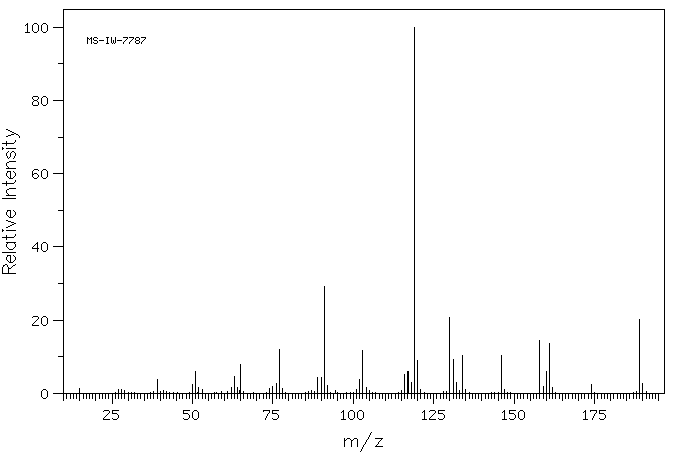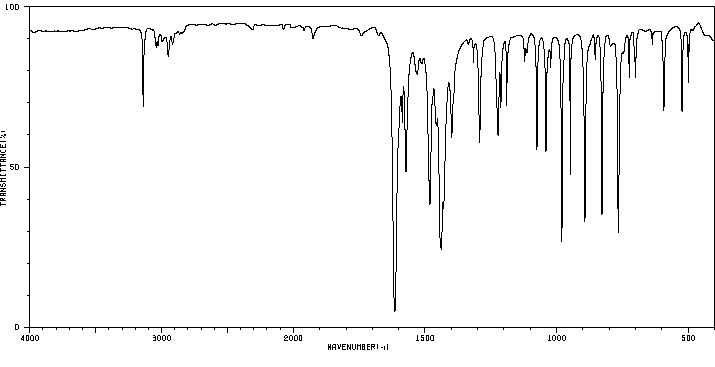5-methoxy-3-(p-tolyl)isoxazole | 25755-83-3
中文名称
——
中文别名
——
英文名称
5-methoxy-3-(p-tolyl)isoxazole
英文别名
5-methoxy-3-(4-methylphenyl)isoxazole;3-p-Tolyl-5-methoxyisoxazol;5-Methoxy-3-(4-methylphenyl)-1,2-oxazole;5-methoxy-3-(4-methylphenyl)-1,2-oxazole
CAS
25755-83-3
化学式
C11H11NO2
mdl
——
分子量
189.214
InChiKey
QFDWXEKSMFDHMU-UHFFFAOYSA-N
BEILSTEIN
——
EINECS
——
-
物化性质
-
计算性质
-
ADMET
-
安全信息
-
SDS
-
制备方法与用途
-
上下游信息
-
文献信息
-
表征谱图
-
同类化合物
-
相关功能分类
-
相关结构分类
计算性质
-
辛醇/水分配系数(LogP):2.7
-
重原子数:14
-
可旋转键数:2
-
环数:2.0
-
sp3杂化的碳原子比例:0.18
-
拓扑面积:35.3
-
氢给体数:0
-
氢受体数:3
上下游信息
-
上游原料
中文名称 英文名称 CAS号 化学式 分子量 —— 3-(4-methylphenyl)-5-chloroisoxazole 51726-08-0 C10H8ClNO 193.633
反应信息
-
作为反应物:描述:5-methoxy-3-(p-tolyl)isoxazole 在 ferrous(II) sulfate heptahydrate 、 N-溴代丁二酰亚胺(NBS) 、 potassium iodide 作用下, 以 氯仿 、 丙酮 、 乙腈 为溶剂, 反应 56.0h, 生成 methyl 2-iodo-3-(p-tolyl)-2H-azirine-2-carboxylate参考文献:名称:通过Halex反应轻松获得2-氟-和2-碘-2H-叠氮基摘要:为酯和2-二烷基酰胺的制备简单克尺度方法(氟/碘)-2 ħ报道通过2-溴取代的类似物的卤素交换(哈莱克斯)反应-azirine -2-羧酸。该方法使用廉价,安全的试剂,Bu 4 NF和碘化钾运行,可提供较高的产品收率。备选地,2-氟-2- ħ -azirine -2-羧酸盐可以由2-碘-和2-氯-类似物制备。后者的化合物可以通过用Bu 4 NCl处理2-碘-和2-溴-2 H-叠氮基-2-羧酸酯以实际上定量的产率获得。DOI:10.1055/s-0039-1690200
-
作为产物:描述:参考文献:名称:杂环化学研究—V:具有酯功能的1-叠氮基的新型合成及其质谱观察摘要:已经发现,可以通过热诱导5-烷氧基异恶唑和5-烷基巯基异恶唑的骨架重排来合成在C具有酯官能的1-叠氮基。通过化学反应以及光谱法对获得的叠氮基进行表征。找不到将叠氮基酯进一步热转化为恶唑衍生物。借助分辨率质谱法对代表性的1-azirines的质谱进行了讨论,其在电子轰击下的行为与它们的化合价异构体5-烷氧基异恶唑的行为相关。DOI:10.1016/s0040-4020(01)97842-1
文献信息
-
Fe(II)/Au(I) Relay Catalyzed Propargylisoxazole to Pyridine Isomerization: Access to 6-Halonicotinates作者:Alexey V. Galenko、Firuza M. Shakirova、Ekaterina E. Galenko、Mikhail S. Novikov、Alexander F. KhlebnikovDOI:10.1021/acs.joc.7b00736日期:2017.5.19An efficient synthesis of methyl nicotinates/6-halonicotinates by the domino isomerization of 4-propargyl/(3-halopropargyl)-5-methoxyisoxazoles under Fe(II)/Au(I) relay catalysis was developed. It was found that FeNTf2 is an effective catalyst for first step of the domino isomerization, transformation of isoxazole to 2H-azirine, which is compatible with Ph3PAuNTf2, catalyzing the second step.
-
Switchable Synthesis of Pyrroles and Pyrazines via Rh(II)-Catalyzed Reaction of 1,2,3-Triazoles with Isoxazoles: Experimental and DFT Evidence for the 1,4-Diazahexatriene Intermediate作者:Nikolai V. Rostovskii、Julia O. Ruvinskaya、Mikhail S. Novikov、Alexander F. Khlebnikov、Ilia A. Smetanin、Anastasiya V. AgafonovaDOI:10.1021/acs.joc.6b02389日期:2017.1.6According to the NMR and DFT investigations of the reaction mechanism, pyrroles and dihydropyrazines are formed, respectively, via 1,5- and 1,6-cyclization of common (5Z)-1,4-diazahexa-1,3,5-triene intermediates. The influence of the nature of the catalyst on the product distribution is rationalized in terms of the Rh-catalyzed isomerization of a pyrrolin-2-ylium-3-aminide zwitterion, the primary product通过调节Rh(II)催化剂和反应条件,由5-烷氧基异恶唑和1-磺酰基-1,2,3-三唑合成了4-氨基吡咯-3-羧酸盐和吡嗪-2-羧酸盐。在100°C的Rh 2(OAc)4催化下于氯仿中的反应可提供高产率的4-氨基吡咯-3-羧酸酯。在回流的甲苯中使用Rh 2(Piv)4会形成1,2-二氢吡嗪-2-羧酸盐作为主要产物,可以通过一锅法将其加热至1,2-二氢吡嗪-2-羧酸盐。催化量的TsOH。根据对反应机理的NMR和DFT研究,吡咯和二氢吡嗪分别通过常见的(5 Z)-1,4-二氮杂六-1,3,5-三烯中间体。催化剂的性质对产物分布的影响通过吡咯烷-2-氨基-3-氨基两性离子的Rh催化的异构化而合理化,吡咯-2-烷基-3-氨基两性离子是1,4-二氮杂己三烯1,5-环化的主要产物。
-
A novel strategy for the synthesis of thermally stable and apoptosis-inducing 2,3-dihydroazetes作者:Ilia A. Smetanin、Mikhail S. Novikov、Anastasiya V. Agafonova、Nikolai V. Rostovskii、Alexander F. Khlebnikov、Igor V. Kudryavtsev、Maxim A. Terpilowski、Maria K. Serebriakova、Andrey S. Trulioff、Nikolay V. GoncharovDOI:10.1039/c6ob00588h日期:——A general and concise approach to thermally and hydrolytically stable alkyl 2,3-dihydroazete-2,3-di-/2,2,3-tricarboxylates from alkyl 2-bromoazirine-2-carboxylates or 4-bromo-5-alkoxyisoxazoles is reported. The synthesis involves the formation of 2-azabuta-1,3-diene by the reaction of rhodium carbenoid with isoxazole or azirine followed by cyclization/hydrodebromination cascade. The latter reaction报道了一种从热的和水解稳定的烷基2-溴叠氮基-2-羧酸烷基酯或4-溴-5-烷氧基异恶唑中的2,3-二氢a杂-2,3-二-/ 2,2,3-三羧酸烷基酯的简便方法。 。合成涉及通过铑类胡萝卜素与异恶唑或叠氮基的反应,然后环化/加氢脱溴级联反应,形成2-azabuta-1,3-diene。后一反应是在平衡条件下化合价异构体选择性加氢脱卤的第一个例子。体外对THP-1细胞系的细胞毒性测试表明,2,3-二氢az嗪在诱导凋亡和/或坏死的能力上有很大差异。为了充分描述和定量评估这些性质,使用了在浓度范围内凋亡/坏死诱导的浓度依赖性曲线下的两个区域之间的差异。发现三苯基4-苯基-2,3-二氢a沸石-2,2,3-三羧酸酯显示最大的凋亡潜力,同时具有高细胞毒性和最小的坏死潜力。
-
Metal-Catalyzed Isomerization of 5-Heteroatom-Substituted Isoxazoles as a New Route to 2-Halo-2H-azirines作者:Mikhail Novikov、Nikolai Rostovskii、Anastasiya Agafonova、Ilia Smetanin、Alexander Khlebnikov、Julia Ruvinskaya、Galina StarovaDOI:10.1055/s-0036-1590822日期:2017.10the synthesis of azirine-2-carboxylates from non-halogenated 5-alkoxyisoxazoles. A convenient gram-scale method for the preparation of 2-halo-2H-azirine-2-carboxylic acid esters, thioesters and amides via metal-catalyzed isomerization of 5-heteroatom-substituted 4-haloisoxazoles is developed. The formation of the esters and amides is efficiently catalyzed by Rh2(Piv)4, while FeCl2·4H2O is the catalyst摘要 开发了一种方便的克级方法,该方法通过5-杂原子取代的4-卤代恶唑的金属催化异构化反应制备2-卤代-2 H-叠氮基-2-羧酸酯,硫代酸酯和酰胺。Rh 2(Piv)4可有效催化酯和酰胺的形成,而FeCl 2 ·4H 2 O是硫代酯合成的选择催化剂。此外,铑催化已成功地用于由非卤代的5-烷氧基异恶唑合成叠氮基-2-羧酸盐。 开发了一种方便的克级方法,该方法通过5-杂原子取代的4-卤代恶唑的金属催化异构化反应制备2-卤代-2 H-叠氮基-2-羧酸酯,硫代酸酯和酰胺。Rh 2(Piv)4可有效催化酯和酰胺的形成,而FeCl 2 ·4H 2 O是硫代酯合成的选择催化剂。此外,铑催化已成功地用于由非卤代的5-烷氧基异恶唑合成叠氮基-2-羧酸盐。
-
An Azirine Strategy for the Synthesis of Alkyl 4-Amino-5-(trifluoromethyl)-1H-pyrrole-2-carboxylates作者:Alexander Khlebnikov、Liya Funt、Olesya Tomashenko、Mikhail NovikovDOI:10.1055/s-0037-1610840日期:2018.12alkyl 4-amino-3-aryl-1-methyl-5-(trifluoromethyl)-1H-pyrrole-2-carboxylates via methylation/hydrazinolysis. 1-(3,3,3-Trifluoro-2,2-dihydroxypropyl)pyridin-1-ium bromide serves as a trifluoromethyl-containing building block for the preparation of trifluoromethyl-substituted aminopyrroles based on the 2H-azirine ring expansion strategy. The primary products, 3-aryl-2-(methoxycarbonyl)-4-(pyridin-1-ium摘要 1-(3,3,3-三氟-2,2-二羟丙基)吡啶鎓-1-溴化物用作含三氟甲基的结构单元,用于基于2 H-叠氮基扩环策略制备三氟甲基取代的氨基吡咯。主要产物3-芳基-2-(甲氧基羰基)-4-(吡啶-1-基-1-基)-5-(三氟甲基)吡咯-1-化物可通过H 2 / PtO 2氢化形成3-芳基-4-(哌啶-1-基)-5-(三氟甲基)-1 H-吡咯-2-羧酸烷基酯并转化成4-氨基-3-芳基-1-甲基-5-(三氟甲基)烷基-1 H-吡咯-2-羧酸盐通过甲基化/肼解作用。 1-(3,3,3-三氟-2,2-二羟丙基)吡啶鎓-1-溴化物用作含三氟甲基的结构单元,用于基于2 H-叠氮基扩环策略制备三氟甲基取代的氨基吡咯。主要产物3-芳基-2-(甲氧基羰基)-4-(吡啶-1-基-1-基)-5-(三氟甲基)吡咯-1-化物可通过H 2 / PtO 2氢化形成3-芳基-4-(哌啶-1-基)-5-(三氟甲基)-1
表征谱图
-
氢谱1HNMR
-
质谱MS
-
碳谱13CNMR
-
红外IR
-
拉曼Raman
-
峰位数据
-
峰位匹配
-
表征信息
同类化合物
(βS)-β-氨基-4-(4-羟基苯氧基)-3,5-二碘苯甲丙醇
(S,S)-邻甲苯基-DIPAMP
(S)-(-)-7'-〔4(S)-(苄基)恶唑-2-基]-7-二(3,5-二-叔丁基苯基)膦基-2,2',3,3'-四氢-1,1-螺二氢茚
(S)-盐酸沙丁胺醇
(S)-3-(叔丁基)-4-(2,6-二甲氧基苯基)-2,3-二氢苯并[d][1,3]氧磷杂环戊二烯
(S)-2,2'-双[双(3,5-三氟甲基苯基)膦基]-4,4',6,6'-四甲氧基联苯
(S)-1-[3,5-双(三氟甲基)苯基]-3-[1-(二甲基氨基)-3-甲基丁烷-2-基]硫脲
(R)富马酸托特罗定
(R)-(-)-盐酸尼古地平
(R)-(-)-4,12-双(二苯基膦基)[2.2]对环芳烷(1,5环辛二烯)铑(I)四氟硼酸盐
(R)-(+)-7-双(3,5-二叔丁基苯基)膦基7''-[((6-甲基吡啶-2-基甲基)氨基]-2,2'',3,3''-四氢-1,1''-螺双茚满
(R)-(+)-7-双(3,5-二叔丁基苯基)膦基7''-[(4-叔丁基吡啶-2-基甲基)氨基]-2,2'',3,3''-四氢-1,1''-螺双茚满
(R)-(+)-7-双(3,5-二叔丁基苯基)膦基7''-[(3-甲基吡啶-2-基甲基)氨基]-2,2'',3,3''-四氢-1,1''-螺双茚满
(R)-(+)-4,7-双(3,5-二-叔丁基苯基)膦基-7“-[(吡啶-2-基甲基)氨基]-2,2”,3,3'-四氢1,1'-螺二茚满
(R)-3-(叔丁基)-4-(2,6-二苯氧基苯基)-2,3-二氢苯并[d][1,3]氧杂磷杂环戊烯
(R)-2-[((二苯基膦基)甲基]吡咯烷
(R)-1-[3,5-双(三氟甲基)苯基]-3-[1-(二甲基氨基)-3-甲基丁烷-2-基]硫脲
(N-(4-甲氧基苯基)-N-甲基-3-(1-哌啶基)丙-2-烯酰胺)
(5-溴-2-羟基苯基)-4-氯苯甲酮
(5-溴-2-氯苯基)(4-羟基苯基)甲酮
(5-氧代-3-苯基-2,5-二氢-1,2,3,4-oxatriazol-3-鎓)
(4S,5R)-4-甲基-5-苯基-1,2,3-氧代噻唑烷-2,2-二氧化物-3-羧酸叔丁酯
(4S,4''S)-2,2''-亚环戊基双[4,5-二氢-4-(苯甲基)恶唑]
(4-溴苯基)-[2-氟-4-[6-[甲基(丙-2-烯基)氨基]己氧基]苯基]甲酮
(4-丁氧基苯甲基)三苯基溴化磷
(3aR,8aR)-(-)-4,4,8,8-四(3,5-二甲基苯基)四氢-2,2-二甲基-6-苯基-1,3-二氧戊环[4,5-e]二恶唑磷
(3aR,6aS)-5-氧代六氢环戊基[c]吡咯-2(1H)-羧酸酯
(2Z)-3-[[(4-氯苯基)氨基]-2-氰基丙烯酸乙酯
(2S,3S,5S)-5-(叔丁氧基甲酰氨基)-2-(N-5-噻唑基-甲氧羰基)氨基-1,6-二苯基-3-羟基己烷
(2S,2''S,3S,3''S)-3,3''-二叔丁基-4,4''-双(2,6-二甲氧基苯基)-2,2'',3,3''-四氢-2,2''-联苯并[d][1,3]氧杂磷杂戊环
(2S)-(-)-2-{[[[[3,5-双(氟代甲基)苯基]氨基]硫代甲基]氨基}-N-(二苯基甲基)-N,3,3-三甲基丁酰胺
(2S)-2-[[[[[((1S,2S)-2-氨基环己基]氨基]硫代甲基]氨基]-N-(二苯甲基)-N,3,3-三甲基丁酰胺
(2S)-2-[[[[[[((1R,2R)-2-氨基环己基]氨基]硫代甲基]氨基]-N-(二苯甲基)-N,3,3-三甲基丁酰胺
(2-硝基苯基)磷酸三酰胺
(2,6-二氯苯基)乙酰氯
(2,3-二甲氧基-5-甲基苯基)硼酸
(1S,2S,3S,5S)-5-叠氮基-3-(苯基甲氧基)-2-[(苯基甲氧基)甲基]环戊醇
(1S,2S,3R,5R)-2-(苄氧基)甲基-6-氧杂双环[3.1.0]己-3-醇
(1-(4-氟苯基)环丙基)甲胺盐酸盐
(1-(3-溴苯基)环丁基)甲胺盐酸盐
(1-(2-氯苯基)环丁基)甲胺盐酸盐
(1-(2-氟苯基)环丙基)甲胺盐酸盐
(1-(2,6-二氟苯基)环丙基)甲胺盐酸盐
(-)-去甲基西布曲明
龙蒿油
龙胆酸钠
龙胆酸叔丁酯
龙胆酸
龙胆紫-d6
龙胆紫








